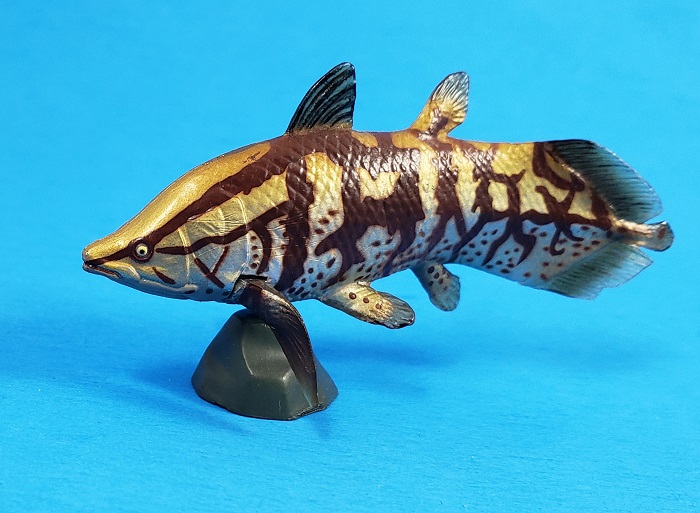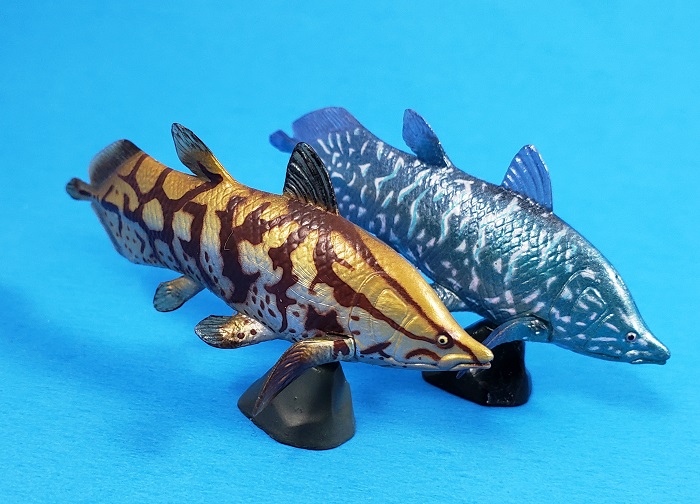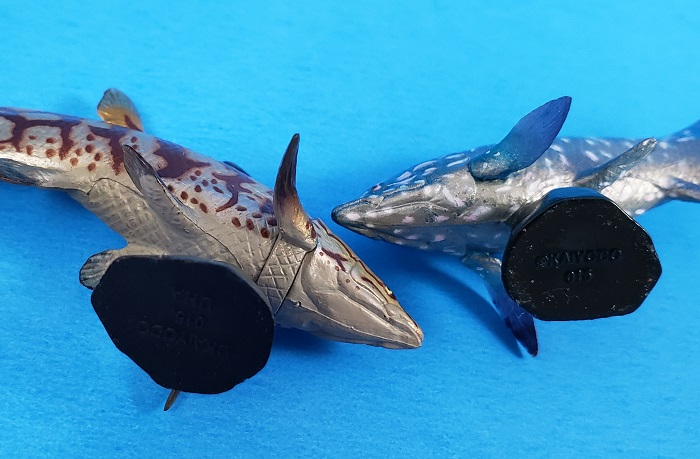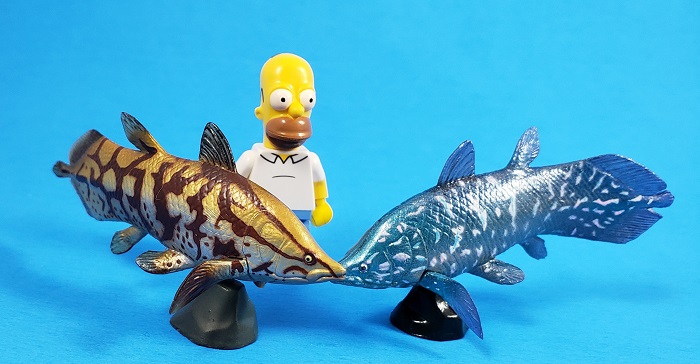When you hear the term “living fossil,” one of the first examples you’re likely to think of is the coelacanth. Fossil coelacanths were first described over 160 years ago, and their fossil record spans the Mesozoic, even reaching back to the Devonian. That means coelacanths have been on Earth for more than twice as long as mammals, but there are no fossils known from later than the Cretaceous. It was quite a sensation, then, when Marjorie Courtenay-Latimer brought the gombessa (the living coelacanth species found off the coast of Africa) to the attention of European scientists in the 1930s. Given its iconic status as a living fossil, it’s little wonder that prehistoric themed toy lines often include a coelacanth. However, it is nearly always the modern gombessa, rather than any of the very many known species of fossil coelacanth, which perhaps indicates that people take the term “living fossil” a little too literally–the living genus Latimeria has exactly zero known fossils. Today’s review concerns the only exception to the modern-coelacanth-in-a-prehistoric-toy-line trend that I’m aware of: Axelrodichthys by Kaiyodo.
Axelrodichthys was a mid-sized coelacanth found in the Crato and Santana formations in Brazil. These deposits represent a shallow sea that formed as Africa and South America moved away from each other during the Cretaceous period. This is the same geological setting that gave us famous pterosaurs like Anhanguera, Tupandactylus, Thalassodromeus, Tropeognathus, and Tupuxuara. Axelrodichthys contains two known species, but at the time this figure was released in 2001, only one of those species, A. araripensis, had been described. There are multiple fossils representing a range of age classes, the largest being approximately 75 centimeters long. That’s about half the length of a large modern coelacanth. The preservation is phenomenal, so we know quite a lot about what Axelrodichthys looked like. To my mind, that makes this a great choice for a figurine.

The Kaiyodo figure is a shade over 7 cm long, making it just about 1:10 scale. The overall shape is faithful to the known adult fossils, with a long snout and somewhat concave profile, quite different from a modern gombessa. The position and orientation of the fins, and the fleshy bases on all but the anterior dorsal fin, show clearly that this is a coelacanth, and reflect Kaiyodo’s typical punctiliousness. The dermal bones of the operculum and the texture of the scales help make this a beautiful, lifelike little model.

The figure comes in two color versions. The first released was the glossy, almost iridescent blue one with streaky white marks. This is really similar to a modern coelacanth, and while it looks nice, it isn’t very likely that ancient coelacanths like Axelrodichthys would have looked like this. The modern coelacanth lives in fairly deep waters far out on continental shelves, not in freshwater or brackish habitats like the ones where Axelrodichthys was found, so with their different ecology we wouldn’t expect similar coloration. The second color version, released a few months later, is a brown-streaked bronze color. It looks as though it was inspired by a juvenile Japanese barramundi, or akame (Lates japonicus), whose silhouette is reminiscent of Axelrodichthys. The akame is probably a better ecological analogue, to boot. Like most of the paint jobs on the second versions of Kaiyodo’s Series 1 Dinotales figures, I think this one is an improvement.

The second version also has slightly tweaked joinery. The support post enters the belly at a different angle, changing the fish’s swimming attitude. And the pectoral fins are a single piece rather than two separate pieces. This configuration is much more stable: if you don’t glue the pectorals into place on the blue version, they are likely to fall out from time to time, a problem I have never had with the bronze edition.

With a rich fossil record of ecologically diverse and downright strange coelacanths like Allenypterus, Miguashaia, and Rebellatrix, it’s a bit of a pity that so many prehistoric lines only include the gombessa as a stand-in. But this gorgeous Axelrodichthys takes some of the sting out of it. After over 15 years, it still holds up. I can’t recommend it strongly enough. It’s reasonably easy to find on secondary market sites, but expect to pay a couple of dollars extra if you want the apparently scarcer second edition.

Disclaimer: links to Ebay and Amazon on the DinoToyBlog are affiliate links, so we make a small commission if you use them. Thanks for supporting us!




(I’m trying this again…)
For prehistoric coelacanths…there is another! Sort of. Attached to the Takara Expo Spinosaurus is a Mawsonia, labelled on the figure and everything! It’s permanently attached. but it is different…and actually looks like a Mawsonia.
Also, if the WS Coelacanth is considered fair game for the blog (it’s on here somewhere) does that open it up to other ‘primitive’ and ‘living fossil’ fishes too? Still not an especially big group…but still.
On the WS coelacanth, I think that’s a bit of a special case because it was issued as part of the prehistoric line, even though to my way of thinking it properly belongs to the marine life line. Personally I would be a bit rankled to see a profusion of other Latimeria figures reviewed here as though they were extinct animals. I would find extending that to gars, lungfishes, etc. even more irritating. However, due to its being part of a prehistoric line, I wouldn’t mind seeing the Airfix model kit Pteranodon with coelacanth reviewed, even though that too looks like a Latimeria.
I always forget about the Takara Tomy Spinosaurus with Mawsonia. It’s fused into the jaw and also very tiny, so I find it very unsatisfying as a representation. But you’re right that technically that makes the Axelrodichthys no longer, strictly speaking, the only fossil coelacanth in plastic.
Nice review–always good to see fishies!
So, in thinking of fish reviews–there is a WS Coelacanth. Does that open it up to other modern-but-living fossil fishes? Just, you know, thinking…!
As for the only fossil coelacanth figure, there is another. Sort of. The Takara Spinosaurus has a Mawsonia in its mouth (the model even labels it as such, and the head and tail are shaped apparently correctly). It’s tiny, but there–and it counts! Until a real one is made…
@Shonisaurus: The seams are all on the belly, they are not at all obvious when the fish is on display.
@Lanthanotus: arapaima and coelacanth seems about right! You’re right that only a small fraction of Kaiyodo’s figures have been reviewed. I guess we should remedy that!
@KYM Jacob. Thanks for the kind words! No actinistian records after the K-Pg turned up when I ran a query on PaleoDB, but of course PaleoDB is incomplete, and, to be fair, no Mesozoic references to Macropomoides were there either. I obviously think a Miocene Macropomoides would be very exciting, so I looked into “M. palaestina” and the only reference I could find to it was a web site that appears to be serving as its official “description.” The specimen is not figured (the only image is of the earlier Macropomoides orientalis), the descriptive anatomy seems lifted directly from another paper, there is no evidence it was peer-reviewed, and no evidence is offered as to the provenance of the specimen other than the assertion that it is from Anthracothere Hill. Finally, while not unheard of, a coelacanth genus persisting from the Cenomanian (~95 ma) to the Miocene (5-23 ma) would be unusual. I’m really having a hard time seeing a reason to regard “M. palaestina” as anything other than a nomen nudum, but I’d love to see another source if you know of one.
Great review. Both figures look great, and I’m glad to see the breakdown on the reasoning on the color scheme. One thing I did notice in passing about the review though. While at the time Coelacanths were only known from the Cretaceous or older when the first recently living specimens were discovered by science, the species Macropomoides palaestina was found scince then from the miocene.
Nice to see another Dinotales review, still lot of figures left out of this line. And fish are especially rare here. That fish looks like the lovechild of an Arapaima and a Coelacanth, great figure, as all of those Dinotales figures. Would love to see those sculpts double or triple sized in PVC 😀
The blue version of the axelrodichthys fish of Kaiyodo Dinotales has no seams and it seems better than the other version.
I have figures of Kaiyodo and I have to affirm that the miniatures are great like those of other Japanese oriental companies, like Favorite, Colorata or Sega to give some examples.